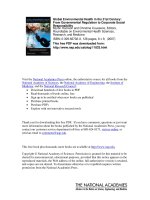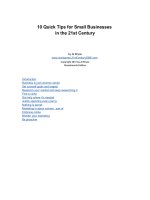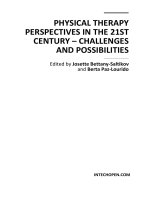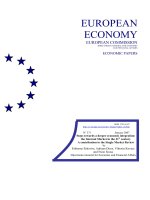- Trang chủ >>
- Khoa Học Tự Nhiên >>
- Vật lý
china in the 21st century what everyone needs to know apr 2010
Bạn đang xem bản rút gọn của tài liệu. Xem và tải ngay bản đầy đủ của tài liệu tại đây (1.12 MB, 187 trang )
CHINA IN THE 21ST CENTURY
This page intentionally left blank
CHINA IN
THE 21ST CENTURY
WHAT EVERYONE NEEDS TO KNOW
JEFFREY N. WASSERSTROM
1
2010
1
Oxford University Press, Inc., publishes works that further
Oxford University’s objective of excellence
in research, scholarship, and education.
Oxford New York
Auckland Cape Town Dar es Salaam Hong Kong Karachi
Kuala Lumpur Madrid Melbourne Mexico City Nairobi
New Delhi Shanghai Taipei Toronto
With offi ces in
Argentina Austria Brazil Chile Czech Republic France Greece
Guatemala Hungary Italy Japan Poland Portugal Singapore
South Korea Switzerland Thailand Turkey Ukraine Vietnam
Copyright © 2010 by Jeffrey N. Wasserstrom
Published by Oxford University Press, Inc.
198 Madison Avenue, New York, New York 10016
www.oup.com
Oxford is a registered trademark of Oxford University Press.
All rights reserved. No part of this publication may be reproduced,
stored in a retrieval system, or transmitted, in any form or by any means,
electronic, mechanical, photocopying, recording, or otherwise,
without the prior permission of Oxford University Press.
Library of Congress Cataloging-in-Publication Data
Wasserstrom, Jeffrey N.
China in the 21st century : what everyone
needs to know/ Jeffrey N. Wasserstrom.
p. cm.
Includes bibliographical references and index.
ISBN 978-0-19-539447-4; 978-0-19-539412-2 (pbk.)
1. China—History—21st century. I. Title.
II. Title: China in the twenty-fi rst century.
DS779.4.W376 2010
951.06—dc22 2009045415
135798642
Printed in the United States of America
on acid-free paper
CONTENTS
ACKNOWLEDGMENTS xi
AUTHOR’S NOTE xiv
MAP xviii
PART I: HISTORICAL LEGACIES
1 Schools of Thought 1
Who was Confucius? 1
What were Confucius’s core ideas? 2
What was his political vision? 2
How important was history to Confucius? 3
Has Confucius always been venerated in China? 4
Was Confucius celebrated in his own times? 5
When did the ideas of Confucius gain infl uence? 7
How was Confucius viewed a century ago? 8
Is Confucianism a religion? 9
How has Confucius fared since 1949? 10
Why is Confucius back in favor? 11
How exactly is the new regime using Confucius? 13
Did Confucianism hinder imperial China’s economic development? 14
vi Contents
Does China have an indigenous “democratic” tradition? 16
What is the Chinese term for democracy and
what exactly does it mean? 17
2 Imperial China 19
What were the main early dynasties? 19
How did dynasties rule? 20
What was the “dynastic cycle”? 21
What were the political implications of this cyclical view? 22
Were all dynasties the same? 22
How did dynasties interact with foreign countries? 24
What was the Opium War? 25
Why did the Qing Dynasty fall? 26
What internal developments weakened the Qing? 27
What was the signifi cance of peasant rebellions? 27
What impact did the Opium War have? 28
What was the Taiping Uprising? 29
Why was the 1894–1895 War with Japan so important? 30
What was the Boxer Rebellion (1899–1901)? 30
How has this crisis been misunderstood? 31
How does the reputation of the crisis differ in China? 32
Why does this difference in views of the Boxers matter? 32
How did Qing rule fi nally end? 33
Is the Chinese Communist Party a new dynasty? 34
3 Revolutions and Revolutionaries 36
Who was Sun Yat-sen? 36
What happened to Sun after he became president? 37
What was the “Warlord era”? 37
What was the May 4th movement? 38
Contents vii
Who was the most important radical writer of the May 4th era? 39
How does the Communist Party view the May 4th era? 41
Why was the example of the Russian Revolution so important? 42
What was the First United Front? 42
Why was the May 30th movement important? 43
What was the Northern Expedition? 43
Who was Chiang Kai-shek? 44
What was the Long March? 45
What was the Rape of Nanjing? 46
How did the Communists beat the Nationalists? 47
What role have mass campaigns played in
the People’s Republic of China? 49
What were some important early mass campaigns? 50
What was the Resist America, Support Korea campaign? 51
What was the Hundred Flowers campaign? 52
What happened during the Anti-Rightist campaign? 53
What sort of people were Mao and his main allies? 53
How were Mao’s writings viewed? 55
What was the Great Leap Forward? 56
What was the Cultural Revolution? 57
What was the Gang of Four? 59
Why hasn’t Mao been repudiated by China’s current leaders? 59
What is the alternative to viewing Mao as a monster? 61
Is Mao seen in China as someone who made errors? 62
How do ordinary Chinese feel about Mao? 63
PART II: THE PRESENT AND THE FUTURE
4 From Mao to Now 67
Who was Deng Xiaoping? 67
Who were Deng’s successors? 69
viii Contents
What exactly did Deng do? 69
How is Deng viewed now? 70
What was the Democracy Wall movement? 71
What is the real story of the Tiananmen Uprising? 72
Why hasn’t the Chinese government changed its line on Tiananmen? 75
What effect did the fall of other Communist governments have on China? 76
How did China’s rulers avoid falling prey to the “Leninist extinction”? 78
How has the government responded to protests since 1989? 80
Why and how has the CCP suppressed the Falun Gong movement? 81
Who are the Chinese dissidents now? 82
What is the role of the Internet in political dissent? 84
What does the digital divide mean in China? 85
Why were the 2008 Olympics such a big deal for China? 86
What was unusual about China’s preparations for the 2008 Olympics? 87
What does the handling of the Olympics say about today’s China? 88
Will grand spectacles continue to be important to China? 91
Why hold an Expo so soon after the Olympics? 91
What is the “One-Child Family” policy? 93
Was female infanticide encouraged to help limit population size? 95
Is contemporary China utterly unique? 96
What does China have in common with other countries? 98
Is the Great Firewall of China a unique structure? 100
5 U.S.–China Misunderstandings 103
What is the most common thing Americans get wrong about China? 103
Why is China’s diversity overlooked? 104
How does ethnicity come into the picture? 105
How important are regional divides? 106
How important are age divides in China? 107
Is China still truly an atheist state? 108
Contents ix
Is China a Big Brother state? 109
What is the biggest source of Chinese misunderstanding of
the United States? 112
How do U.S. and Chinese views on Tibet differ? 113
6 The Future 116
Is China bent on world domination? 116
How likely is a war with Taiwan? 118
Will China become the world’s dominant economic power? 120
Will China, long thought of as a land of villages,
soon be a land of cities? 121
Is China likely to become a democracy? 123
How powerful is Chinese nationalism? 123
What kind of government will China have in a decade? 125
What big challenges lie ahead for the CCP? 126
What big issues relating to the environment and energy
does China face? 127
Why is endemic corruption such a serious problem? 129
How can the United States and China adjust to an era in which
they are the two superpowers? 131
What other kinds of things do China and the United States
have in common? 133
Is this an argument for Americans to refrain from
all criticism of China? 134
NOTES 137
FURTHER READING 147
INDEX 157
This page intentionally left blank
ACKNOWLEDGMENTS
I owe debts of gratitude to many individuals, beginning with
the students who have taken my classes and the people who
have attended the talks on China I’ve given in some fourteen
different countries located on four continents over the course
of the last two decades. The questions they have asked me
helped me fi gure out which ones to address in this volume.
I am enormously grateful to Tim Bent and Dayne Poshusta at
Oxford University Press, and the anonymous readers of the
book proposal they solicited, for providing me with guid-
ance in refi ning my list of questions. I also want to thank Tim,
the editor in charge of the project, for his unvarying support,
unfailing good humor, and the work he did on tightening up
the book’s prose; and Dayne, for bringing a sharp set of eyes to
the manuscript at a key stage in its development.
I want to thank the following friends and colleagues who
helped me greatly by answering my inquiries, listening to
me try out ideas, sharing unpublished works, or reading and
commenting on one or more chapters at very short notice:
Susan Brownell, Tim Oakes, Tim Weston, Lisa Claypool, Susan
Fernsebner, Lee Haiyan, Sara Friedman, Benjamin Read, and
Kate Merkel-Hess (who deserves a special separate expression
of thanks, since various parts of the book were shaped by work
she and I did on coauthored commentaries). Going even further
beyond the call of duty (and perhaps even friendship), Vanessa
xii Acknowledgments
Schwartz, Rob Culp, Peter Zarrow, and Kate Edgerton-Tarpley
made time to read entire drafts of the manuscript (again at very
short notice) and gave me valuable suggestions about how to
improve it.
I am grateful to many colleagues, fi rst at Indiana Univer-
sity and now at the University of California–Irvine, for conver-
sations that have contributed to my understanding of China
and the ways that it is similar to or different from other coun-
tries. There are too many people to list, but I’d be remiss not
to mention Maria Bucur, Jeff Isaac, Jeff Gould, Nick Cullather,
Mike Grossberg, John Bodnar, Sue Tuohy, Scott O’Bryan, Scott
Kennedy, Jeff Veidlinger, Ben Nathans, Mark Roseman, Kumble
Subbaswamy, and Michael Curtin (among those formerly or still
at IU) as well as, at UCI, Ken Pomeranz, Vinayak Chaturvedi,
Bob Moeller, Emily Rosenberg, Yong Chen, Guo Qitao, Dorothy
Solinger, Laura Mitchell, Kavita Philip, and Jennifer Munger.
I also want to thank everyone involved with the “China Beat”
blog, which was launched at UCI in January 2008. Participating
in that venture has provided me with an invaluable continuing
education, both about the PRC and about writing, while also
offering a wonderful example of what can be accomplished by a
group ready to blur or ignore completely the divides that sepa-
rate, often unnecessarily, the work done by graduate students
as opposed to faculty members, academics as opposed to free-
lance writers with a scholarly bent, and so on. I am grateful to
all the “China Beat” contributors (too numerous by this point
to list), and especially to Kate Merkel-Hess, Ken Pomeranz,
Maura Cunningham, Miri Kim, and Susan McEachern for being
such good collaborators on the blog and the related book, China
in 2008: A Year of Great Signifi cance, which grew out of it.
I owe a special thank you to Nicole Rebec, for giving a complete
early draft of this book a careful and thoughtful read for style. And
I am very grateful to Nancy Toff, for fi rst getting me involved in
the operations of OUP’s wonderful New York offi ce.
I want to thank as well Pankaj Mishra, Geremie Barmé,
Timothy Garton Ash, Alec Ash, Prasenjit Duara, Harriet Evans,
Acknowledgments xiii
Mark Selden, Timothy Weston, Mary Gallagher, Liz Perry, Gail
Hershatter, and Barbara Mittler for conversations or e-mail
exchanges we had during 2009 on issues associated with topics
covered in this book, which they may by now have forgotten
but that shaped my thinking on key issues. In the acknowl-
edgments to an earlier book, I thanked the editors at various
general interest periodicals whose comments on short pieces
I had worked on for them helped me make the transition from
writing just for academics to writing for the public at large.
I remain in their debt, and I now want to add a few new names
to that list: Joan Connell, Josh Burek, Kate Palmer, Liam Fitz-
patrick, Colin McMahon, and Nick Goldberg.
I am grateful as well to Michael Freeman, the inspiring
teacher who taught me the fi rst things I ever “needed to know”
about China, back when I was a freshman. And the fi nal person
I want to thank is, as always, Anne Bock. For the usual reasons,
plus in this case for all she does to help keep me aware of the
difference between things that “everyone needs to know about
China” and things that I simply fi nd interesting about the
country.
AUTHOR’S NOTE
When I took my fi rst class in Chinese history in the late 1970s,
signing up for it on a whim, getting a clearer sense of the past
and present of the world’s most populous nation seemed purely
optional, in a way that it no longer does. At the time, I had
only a passing familiarity with Chinese culture, politics, and
society. This was partly because reports about China made it
into network newscasts (then still a very infl uential medium)
only when something very extraordinary happened, such as
when President Richard Nixon made his historic trip to Beijing
in February 1972. Stories about the People’s Republic of China
(PRC) only rarely made it onto the front pages of English-
language newspapers and almost never appeared in the sports,
business, or entertainment sections.
What a difference thirty years can make in the life of
a country—and in the degree of global interest it gener-
ates. Stories about the PRC show up in Western newspapers
routinely (not just at moments of crisis) and appear in every
section (even the sports pages, thanks fi rst to Yao Ming—the
Shanghai-born center for the Houston Rockets—and then to
the 2008 Olympics). Moreover, reports about Chinese topics are
staples in other kinds of media, from CNN broadcasts to online
venues such as the Huffi ngton Post.
And yet, as Timothy Garton Ash noted in a recent Los Angeles
Times op-ed, we English-language readers still get much less
Author’s Note xv
thorough coverage of China than we need, given how complex
the country is and how loomingly important its role in global
affairs has become.
We now live in an era when China has more millionaires,
more cities with populations exceeding one million, more
Internet users, and more skyscrapers than any other country. It
fi gures centrally in the most pressing issues of our day. China
produces more greenhouse gases than any other nation. It has
vast holdings of U.S. treasury bonds and its factories fi ll the
shelves of the world’s big-box stores. China not only has the
bomb, but it also maintains a special relationship with North
Korea, a country whose nuclear ambitions are a source of grave
concern in the West.
Given all this, the need for a book on China’s present, subti-
tled “what everyone needs to know,” is self-evident. The ways
it is developing and being infl uenced by other parts of the
world and how it, in turn, is infl uencing other nations are of
widespread fascination and concern. How China fares in the
21st century matters to everyone on the planet.
The goal of this book is to help normalize discussions of
China, a country that is too often seen as—to use the cliché—
inscrutable. My aim is to clear up sources of Western misun-
derstanding about China, provide insights into issues of
signifi cance relating to it, and, above all, reveal that, though
it can be dauntingly complex, we can arrive at a basic under-
standing of its nature. To do this, I begin with several chapters
on China’s past and the relevance of this history for contem-
porary dilemmas, and then conclude with several that zero in
on China’s present.
In pursuing this goal, I continually draw upon research I did
in China between August 1986 and July 1987, when working on
what would become my fi rst book (a study of student protests).
I also make use of what I have learned in the course of frequent
trips to the PRC since then, including recent ones during which
I have felt as though I were in a country separated by a century
rather than just a few decades from the one I fi rst encountered.
xvi Author’s Note
I root my discussion as well in the primary-source readings
I have done for various projects, including a monograph on the
recent, dramatic transformation of Shanghai.
Many parts of the book, however, rely on the important
work that others have done on topics ranging from the massive
rural-to-urban migration (the largest in human history) that is
transforming China’s social landscape to the political legacy of
Mao Zedong (Mao Tse-tung) (1893–1976).
1
In addition to schol-
arly books, I rely on the work of a large coterie of very fi ne jour-
nalists and freelance writers who are contributing to what one
scholar has aptly dubbed a “second Golden Age” of foreign
writing about China.
2
These writers are providing stories and
information to readers outside of China that challenge the
stereotypes and oversimplifi cations that are so often buttressed
by sound bite–driven reports and puffed up punditry about
the PRC. The following chapters seek to contribute to this effort
and to show, in passing, some of the ways in which the West is
misunderstood by China.
It is important to note two things, each of which relates
to the scope of this book. I want to stress fi rst that this work,
although aimed at readers in all parts of the world, has inevi-
tably been shaped by the fact that I am most familiar with the
questions that Americans have about China, and the kinds of
ideas and misconceptions about the PRC that circulate within
the United States. One chapter is, in fact, devoted exclusively
to U.S. misunderstandings of China, Chinese misunderstand-
ings of the United States, and the things that the two coun-
tries, which often present themselves as completely unlike one
another, have in common.
There are some advantages to reading a book on China that
has an American tilt, such as this one does. The current moment
is one in which the United States and China both have enor-
mous economic clout and geopolitical signifi cance. It is also
a time when the two countries stand out in other ways: for
example, the former is the largest per capita producer and the
latter the largest overall producer of greenhouse-gas emissions.
Author’s Note xvii
In such a setting, getting a sense of how people in these two
countries view one another is arguably something everyone
needs to know about the world.
Second, like other books in this series, this one does not
strive to be encyclopedic, and many issues that will only be
touched on, both in the opening three chapters devoted to
historical legacies and in the closing three chapters that focus
on contemporary dilemmas and future prospects, could easily
be and indeed have been the focus of entire books. Still, I hope
this work will provide a set of big frameworks, specifi c details,
and new thinking on familiar issues so that the reader will
come away with a clearer sense of a country that is, and will
undoubtedly remain, a central player in many of the biggest
stories of the 21st century.
Adapted from a map created by Alice Thiede for China: Fragile Superpower by Susan L. Shirk
(Oxford University Press, 2008).
To understand today’s China, it is crucial to know something
about its past. And especially important for our purposes are
those aspects of history that have direct relevance for contem-
porary developments, whether because of the precedent they
set or because current leaders present themselves as breaking
away from them or carrying them forward. With this in mind,
and determined to avoid a wearying and confusing march
through all the dynasties, the following three chapters offer up
a selective (but I hope illuminating), quick march through the
two millennia plus that get China from Confucius to Mao. The
fi rst chapter introduces major early Chinese schools of thought
(especially the ideas of Confucius, since today’s leaders seek
to present today’s China as a place where “Confucian” and
Communist ideals complement one another). It also looks at the
place that democratic traditions have had in China, showing
that these are not just recent imports from the West. The second
chapter focuses on political structures and major political ideas,
including the concept of the “Mandate of Heaven,” which legit-
imated imperial rule with reference to the interplay between
spiritual and earthly dynamics. As well, it examines the simi-
larities and differences between the ways that successive ruling
houses (dynasties) governed China from the 3rd century b.c.e.
until 1912, the year that China’s last emperor abdicated and
a republican form of government was establishing. Rounding
PART I
HISTORICAL LEGACIES
xxii CHINA IN THE 21ST CENTURY
out this fi rst part of the book is a chapter on “Revolutions and
Revolutionaries,” which looks at the events and people who
transformed the country during the period lasting from 1912
until Mao’s death. It ends with a look at Mao’s posthumous
legacy, emphasizing the varied ways that the former leader has
been seen and treated in the People’s Republic of China (PRC)
since his demise in 1976.
1
SCHOOLS OF THOUGHT
Who was Confucius?
Confucius (551 b.c.e.–479 b.c.e.) was a teacher and philoso-
pher who lived during the Zhou (Chou) Dynasty (1045–256
b.c.e.), in what is known as the Spring and Autumn era (722
b.c.e.–481 b.c.e.). As with those of his near contemporary
Socrates, none of Confucius’s writings have survived, and his
views come down to us via a text produced after his death.
1
This is the Analects, which contains short statements attrib-
uted to Confucius (the origins of the “Confucius says” fortune
cookie slips, though these were invented either in Japan in
the 1800s or in California in the 1900s) and dialogues between
the sage and his disciples.
2
The book covers a range of topics,
from how a “true gentleman” behaves in his daily life (right
down to how he eats with proper decorum) to how a ruler
should govern (with a benevolent concern for the well-being
of his subjects). One of its most famous statements, linked to
both the high value placed on education in Chinese culture
and the meritocratic aspect of the Chinese political tradition,
is that people are pretty much alike at birth but become differ-
entiated via learning. Another well-known adage from the
Analects says simply that it is a great pleasure to have friends
come to visit from afar.
This adage gained new fame on August 8, 2008, when it was
quoted at the start of the Beijing Games. The line, which was
2 CHINA IN THE 21ST CENTURY
quoted again by a young man who put a question to President
Obama during the Shanghai “town hall” meeting that was part
of the American leader’s November 2009 trip to China, had
obvious relevance for the Olympic Opening Ceremony, since
the live audience for the grand spectacle held in the Bird’s
Nest Stadium included foreign leaders, among them George
W. Bush (the fi rst sitting American president to attend the
Olympics in a foreign country) and Russia’s Vladimir Putin.
Quoting Confucius also fi t with the overall goal of the pageant
and of Chinese Olympic publicity efforts generally, which was
to demonstrate that the PRC has become a country that is open
to the outside world and respectful of China’s ancient as well
as revolutionary traditions and values.
What were Confucius’s core ideas?
The vision of morality sketched out in the Analects emphasizes
the importance of three things: education, ritual, and relation-
ships that are hierarchical yet provide benefi ts to both supe-
rior and inferior. Education was important because it was by
studying the classical texts that a person could learn about and
begin to emulate the actions of the most virtuous fi gures of
past ages, including the legendary sages Yao and Shun (who
lived long before the founding of the Zhou Dynasty) and
fi gures such as the Duke of Zhou (who lived just a few centu-
ries before Confucius). Ritual was important because it was
a physical acting out of the best practices of earlier (and, to
Confucius’s way of thinking, purer) ages. And relationships
in which there was a clear distinction between superior and
inferior were valued, since in these the responsibilities of each
side were clear.
What was his political vision?
Confucius saw political relationships as familial relationships
writ large, meaning, for example, that rulers should behave









